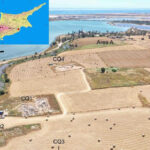Scientists from China and the United States have analyzed the impact glass beads from a lunar soil sample returned by China’s Chang’e-5 mission.
Asteroid and comet impacts are the major exogenous processes that reshape the surface morphologies of airless bodies, as evidenced by the widespread presence of impact craters on the Moon, Mercury and asteroids. These impacts probably create impact glasses and glass beads on any airless bodies. He et al. demonstrate that impact glass beads have the capacity to store significant quantities of solar wind-derived water at the surface of airless bodies, in addition to the possible presence of water ice trapped in permanently shadowed areas in polar regions. The presence of water, stored in impact glass beads, is consistent with the remote detection of water at lower-latitude regions of the Moon, Vesta and Mercury. The findings indicate that the impact glasses on the surface of solar system airless bodies are capable of storing solar wind-derived water and releasing it to space. Image credit: NASA’s Goddard Space Flight Center.
It has long been argued that there could be water and other volatile species at the surface of the Moon.
Renewed lunar exploration and advances in remote-sensing measurements in the 1990s allowed the neutron spectrometer on board NASA’s Lunar Prospector mission to confirm the existence of water ice at the lunar poles.
Following this, the Moon mineralogy mapper instrument on board India’s Chandrayaan-1 spacecraft detected the absorption bands of hydroxyl and/or water on the lunar surface.
Furthermore, NASA’s Lunar Crater Observation and Sensing Satellite impact experiment carried out in 2009 provided direct evidence for high water-ice abundances in permanently shadowed regions within Cabeus crater.
Elevated water-ice abundance in lunar polar regions was further supported by the neutron flux measurements performed by the Lunar Exploration Neutron Detector on board NASA’s Lunar Reconnaissance Orbiter spacecraft.
Recently, the neutral mass spectrometer on NASA’s Lunar Atmosphere and Dust Environment Explorer detected exospheric water liberated by meteoroid impacts, and ground-based telescope observations detected molecular water on the lunar surface.
Today, there is little doubt that most of the Moon’s surface harbors water in one form or another.
However, the origins of this water and its distribution and evolution during regolith gardening remain largely unknown, despite key implications for future lunar surface exploration and for better understanding the surface water reservoir and processing on solar system airless bodies.

Representative electron images (colorized) of the impact glass beads returned by the Chang’e-5 mission. Image credit: He et al., doi: 10.1038/s41561-023-01159-6.
“We proposed that impact glass beads, a ubiquitous component in lunar soils with an amorphous nature, are a potential candidate for investigation of the unidentified hydrated layer or reservoir in lunar soils,” said first author Huicun He, a doctoral student at the Key Laboratory of Earth and Planetary Physics and the University of Chinese Academy of Sciences.
In their research, He and her colleagues analyzed the water content within glass beads produced by impact events, extracted from Chang’e-5 lunar soil samples.
They identified water stored within these impact glass that is consistent with a solar wind origin.
Furthermore, the distribution of water within individual beads indicates that water can rapidly accumulate in glass beads by diffusion, over timescales of only a few years, and be rapidly released.
“These impact glass beads have homogeneous chemical compositions and smooth exposed surfaces,” they said.
“They are characterized by water abundance up to about 2,000 μg/g, with extreme deuterium-depleted characteristics.”
“The negative correlation between water abundance and hydrogen isotope composition reflects the fact that water in the impact glass beads comes from solar wind.”
“The impact glass beads acted as a sponge for buffering the lunar surface water cycle,” they added.
“We estimate that the amount of water hosted by impact glass beads in lunar soils may reach up to 2.7*1014 kg.”
“Our direct measurements of this surface reservoir of lunar water show that impact glass beads can store substantial quantities of solar wind-derived water on the Moon and suggest that impact glass may be water reservoirs on other airless bodies.”
The findings appear in the journal Nature Geoscience.
_____
H. He et al. A solar wind-derived water reservoir on the Moon hosted by impact glass beads. Nat. Geosci, published online March 27, 2023; doi: 10.1038/s41561-023-01159-6




